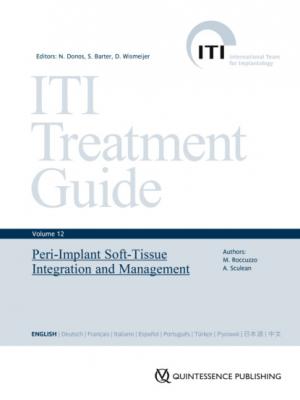Peri‑Implant Soft‑Tissue Integration and Management. Mario Roccuzzo
Чтение книги онлайн.
Читать онлайн книгу Peri‑Implant Soft‑Tissue Integration and Management - Mario Roccuzzo страница 9
 layer of collagen membrane (Bio-Gide; Geistlich) secured with 4-0 Vicryl (Ethicon; Johnson & Johnson International) resorbable sutures.
layer of collagen membrane (Bio-Gide; Geistlich) secured with 4-0 Vicryl (Ethicon; Johnson & Johnson International) resorbable sutures.
Fig 3d After eight weeks of healing, a thick band of keratinized mucosa was visible.
Fig 3e After four months, the dimensions of the ridge were adequate to insert a fixture in the proper position, with no need for further augmentation.
Fig 3f A chemically modified titanium implant was placed (S, WNI SLActive, diameter 4.8 mm, length 12 mm; Institut Straumann AG, Basel, Switzerland).
Fig 3g The soft tissues were circumferentially adapted around the smooth collar of the implant for ideal non- submerged suturing.
Fig 3h Three months after placement, the implant was surrounded by a firm collar of keratinized tissue.
Fig 3i Good stability of the peri-implant soft tissues seven years after placement despite some buccal recession on the adjacent natural premolar.
Fig 4a Part of a panoramic radiograph. Large cyst in the maxillary left sinus. After consultation with an ENT surgeon, who did not suggest any specific treatment, it was decided to place implants without interfering with the sinus.
Fig 4b The left posterior maxilla. The probe used for bone sounding indicated the presence of very thick mucosa in the area of the second molar.
Fig 4c Primary incision lines.
Fig 4d Left posterior maxilla after removal of the excess tissue, which was later used as a graft in the anterior area.
Fig 4e Titanium implant at site 27 with a chemically modified surface (S, WNI SLActive, diameter 4.8 mm, length 10 mm; Institut Straumann AG). The standard implant with a 2.8-mm smooth collar was considered ideal for bringing the margin of the restoration to a more coronal level.
Fig 4f Intraoperative view following the placement of implant 24 (SP, WNI SLActive, diameter 4.1 mm, length 12 mm; Institut Straumann AG). The implant with a 1.8-mm collar was selected to reduce the risk of future soft-tissue dehiscences. The bone concavity on the buccal aspect of the mesial implant is a risk factor for dehiscence.
Fig 4g Autologous bone chips on the buccal aspect of the implant. The connective-tissue graft taken from the posterior area was adapted to protect the bone chips and to increase the width of the crest.
Fig 4h Semi-submerged healing in the anterior grafted area; non-submerged healing with close adaptation of the flap around the collar of the distal implant.
Fig 4i Optimal adaptation of the soft tissues around both implants six weeks after implant placement.
Fig 4j Solid abutments, 4 mm in height, connected eight weeks after implant placement.
Fig 4k Four-unit cemented metal-ceramic bridge in situ.
Fig 4l One-year follow up. Healthy peri-implant soft tissues with minimal probing depth (< 4 mm) and no bleeding after removing the provisionally cemented ceramic bridge.
Fig 4m Radiograph at the five-year follow-up. Stable interproximal bone levels.
One of the challenges in optimal flap design around non-submerged implants is the circumferential closure around the implant collar, especially when the soft tissues present anatomical irregularities. Figures 5a-k show an example of soft-tissue management for non-submerged tissue-level implants in the posterior maxilla with an irregular soft-tissue morphology.
Fig 5a Preoperative situation.
Fig 5b Incision placed slightly palatally to move keratinized tissue onto the buccal side.
Fig 5c Two wide-neck implants placed at sites 26 and 27 (SP, WNI SLActive, diameter 4.8 mm, length 10 mm; Institut Straumann AG).
Fig 5d Incision on the distal portion of the palatal flap.
Fig 5e The pedicle flap was rotated counterclockwise.
Fig 5f Pedicle inserted between the two implants.
Fig 5g The pedicle was adapted with a 4-0 Vicryl vertical mattress suture between the 2 implants.
Fig 5h Final suture, distally to the distal implant.
Fig 5i Preoperative occlusal view.